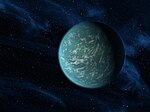 SDSS J102915 172927 as seen by ESO - VLT | |
| Observation data Epoch J2000.0 Equinox J2000.0 | |
|---|---|
| Constellation | Leo |
| Right ascension | 10 29 15.1490 |
| Declination | +17° 29′ 27.925″ |
| Apparent magnitude (V) | +16.92 |
| Characteristics | |
| B−V color index | 0.03 |
| Astrometry | |
| Proper motion (μ) | RA: −10.720(63) mas/yr Dec.: −3.921(54) mas/yr |
| Parallax (π) | 0.6482 ± 0.0598 mas |
| Distance | 5,000 ± 500 ly (1,500 ± 100 pc) |
| Details | |
| Mass | ≤ 0.8 M☉ |
| Temperature | 5811 K |
| Metallicity | ≤ 6.9×10 |
| Other designations | |
| 2MASS J10291514+1729278 | |
| Database references | |
| SIMBAD | data |
SDSS J102915+172927 or Caffau's Star is a population II star in the galactic halo, seen in the constellation Leo. It is about 13 billion years old, making it one of the oldest stars in the Galaxy. At the time of its discovery, it had the lowest metallicity of any known star. It is small (less than 0.8 solar masses), deficient in carbon, nitrogen, oxygen, and completely devoid of lithium. Because carbon and oxygen provide a fine structure cooling mechanism that is critical in the formation of low-mass stars, the origins of Caffau's Star are somewhat mysterious. It has been suggested, both for theoretical and observational reasons, that the formation of low-mass stars in the interstellar medium requires a critical metallicity somewhere between 1.5×10 and 1.5×10.
The metallicity of Caffau's Star is less than 6.9×10. According to Schneider et al., cooling by dust rather than the fine structure lines of CII and OI may have enabled the creation of such low-mass, metal-poor stars in the early universe. The absence of lithium implies past temperatures of at least two million kelvins.
Data from Gaia's DR2 released in 2018 confirmed that SDSS J102915+172927 is a dwarf star.
The star was described by Elisabetta Caffau et al. in an article published by the journal Nature in September 2011. Caffau had been searching for extremely metal-poor stars for the past ten years. It was identified by automated software which analyzed data from the Sloan Digital Sky Survey. This was followed up by observations with the X-shooter and UVES instruments on the Very Large Telescope in Chile. As of 2011 Caffau and her team expect to find between five and fifty similar stars with the telescope in the future.
See also
- Ultra low metallicity / ultra metal poor stars
References
- ^ Vallenari, A.; et al. (Gaia collaboration) (2023). "Gaia Data Release 3. Summary of the content and survey properties". Astronomy and Astrophysics. 674: A1. arXiv:2208.00211. Bibcode:2023A&A...674A...1G. doi:10.1051/0004-6361/202243940. S2CID 244398875. Gaia DR3 record for this source at VizieR.
- ^ Bonifacio, P.; Caffau, E.; Spite, M.; Spite, F.; François, P.; Zaggia, S.; Arenou, F.; Haigron, R.; Leclerc, N.; Marchal, O.; Panuzzo, P.; Plum, G.; Sartoretti, P. (2 May 2018). "Gaia Confirms that SDSS J102915+172927 is a Dwarf Star". Research Notes of the AAS. 2 (2): 19. arXiv:1804.10419. Bibcode:2018RNAAS...2...19B. doi:10.3847/2515-5172/aac0f4. S2CID 85449621.
- Lemonick, Michael D. (2011-09-06). "Cosmic Anomaly: The Star That Shouldn't Exist". TIME. Archived from the original on September 7, 2011. Retrieved 2012-08-20.
- ^ "The Star That Should Not Exist". ESO. 2011-08-31. Retrieved 2012-08-20.
- ^ Schneider, Raffaella; et al. (2012-03-19). "The formation of the extremely primitive star SDSS J102915+172927 relies on dust". Monthly Notices of the Royal Astronomical Society: Letters. 423 (1): L60–L64. arXiv:1203.4234. Bibcode:2012MNRAS.423L..60S. doi:10.1111/j.1745-3933.2012.01257.x. S2CID 119248436.
- ^ Caffau, Elisabetta; Bonifacio, Piercarlo; François, Patrick; Sbordone, Luca; et al. (1 September 2011). "An extremely primitive star in the Galactic halo". Nature. 477 (7362): 67–69. arXiv:1203.2612. Bibcode:2011Natur.477...67C. doi:10.1038/nature10377. PMID 21886158. S2CID 118554326.
- ^ Doyle, Amanda (2011-09-01). "A forbidden star". Astronomynow.com. Archived from the original on 2012-10-19. Retrieved 2012-08-20.
- Redd, Nola Taylor (2011-08-31). "Impossible Star Defies Astronomers' Theories". Space.com. Retrieved 2012-08-20.
| Constellation of Leo | |||||||||||||
|---|---|---|---|---|---|---|---|---|---|---|---|---|---|
| Stars |
| ||||||||||||
| |||||||||||||
| Galaxies |
| ||||||||||||
| 2011 in space | ||
|---|---|---|
| 2012 » | ||
| Space probe launches |
|    |
| Selected NEOs | ||
| Exoplanets |
| |
| Discoveries | ||
| Novae | ||
| Comets | ||
| Space exploration | ||